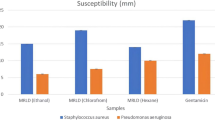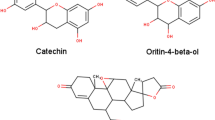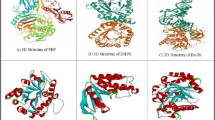Abstract
The antimicrobial properties of the Melaleuca cajuputi plant have been documented. However, the underlying antimicrobial mechanisms remain relatively unexplored. Thus, this study aimed to investigate the antibacterial effects of M. cajuputi leaf extract against selected bacterial strains and unveil the potential antibacterial mechanisms of the most potent sub-fraction through time-kill assay, cell morphology studies, and molecular docking analysis. The fractions and sub-fractions were obtained from the methanolic extract of M. cajuputi leaf by bioassay-guided fractionation. The antibacterial activity was tested against Staphylococcus aureus, Streptococcus agalactiae, Klebsiella pneumoniae, and Escherichia coli using broth microdilution assay. The most potent sub-fraction, Melaleuca fraction 2d (MF2d), demonstrated remarkable antibacterial activity with MIC values ranging from 0.063 to 0.25 mg/mL and induced significant cellular damage against the tested bacteria. The chemical characterization of the most potent sub-fraction (MF2d) from methanolic extract of M. cajuputi leaf identified five (5) compounds with 2-isopropyl-10-methyl phenanthrene (83.09%) as the major component. In-silico molecular docking analysis revealed that all the docked ligands showed strong binding propensity towards target bacterial proteins, including DNA gyrase (PDB ID: 1ZI0), dihydropteroate synthase (PDB ID: 1AD1), and D-alanyl transferase (PDB ID: 6O93) with the binding energy ranging from − 6.0 to − 8.4 kcal/mol. The overall findings demonstrated the potential of the M. cajuputi plant as a valuable source of novel antibacterial agents.






Similar content being viewed by others
Change history
24 June 2024
A Correction to this paper has been published: https://doi.org/10.1007/s13596-024-00767-w
References
Abushaheen MA, Muzaheed FAJ, Alosaimi M, Mansy W, George M, Acharya S, Rathod S, Divakar DD, Jhugroo C, Vellappally S, Khan AA, Shaik J, Jhugroo P (2020) Antimicrobial resistance, mechanisms and its clinical significance. Dis Mon 66:100971. https://doi.org/10.1016/j.disamonth.2020.100971
Adusei EBA, Adosraku RK, Oppong-Kyekyeku J, Amengor CDK, Jibira Y (2019) Resistance modulation action, time-kill kinetics assay, and inhibition of biofilm formation effects of Plumbagin from Plumbago zeylanica Linn. J Trop Med 2019:1–8
Al-Abd NM, Mohamed Nor Z, Mansor M, Azhar F, Hasan MS, Kassim M (2015) Antioxidant, antibacterial activity, and phytochemical characterization of Melaleuca cajuputi extract. BMC Complement Altern Med 15:385. https://doi.org/10.1186/s12906-015-0914-y
Alves MJ, Froufe HJC, Costa AFT, Santos AF, Oliveira LG, Osório SRM, Abreu RMV, Pintado M, Ferreira ICFR (2014) Docking studies in target proteins involved in antibacterial action mechanisms: extending the knowledge on standard antibiotics to antimicrobial mushroom compounds. Molecules 19:1672–1684. https://doi.org/10.3390/molecules19021672
Anza M, Endale M, Cardona L, Cortes D, Eswaramoorthy R, Zueco J, Rico H, Trelis M, Abarca B (2021) Antimicrobial activity, in silico molecular docking, ADMET and DFT analysis of secondary metabolites from roots of three Ethiopian medicinal plants. Adv Appl Bioinform Chem 14:117–132. https://doi.org/10.2147/AABC.S323657
Awam UK (2023) Melaleuca cajuputi powell essential oil: a review of botanical, phytochemical and pharmacological properties. Borneo J Resour Sci Technol 13(2):1–12. https://doi.org/10.33736/bjrst.5314.2023
Bua A, Molicotti P, Donadu MG, Usai D, Le LS, Tran TTT, Ngo VQT, Marchetti M, Usai M, Cappuccinelli P, Zanetti S (2020) “In vitro” activity of Melaleuca cajuputi against mycobacterial species. Nat Prod Res 34(10):1494–1497. https://doi.org/10.1080/14786419.2018.150933
Chen BC, Lin CX, Chen NP, Gao CX, Zhao YJ, Qian CD (2018) Phenanthrene antibiotic targets bacterial membranes and kills Staphylococcus aureus with a low propensity for resistance development. Front Microbiol 9:1593. https://doi.org/10.3389/fmicb.2018.01593
Dighe SN, Collet TA (2020) Recent advances in DNA gyrase-targeted antimicrobial agents. Eur J Med Chem 199:112326. https://doi.org/10.1016/j.ejmech.2020.112326
Egan AJF, Errington J, Vollmer W (2020) Regulation of peptidoglycan synthesis and remodelling. Nat Rev Microbiol 18:446–460. https://doi.org/10.1038/s41579-020-0366-3
Erhabor RC, Aderogba MA, Erhabor JO, Nkadimeng SM, McGaw LJ (2021) In vitro bioactivity of the fractions and isolated compound from Combretum elaeagnoides leaf extract against selected foodborne pathogens. J Ethnopharmacol 273:113981. https://doi.org/10.1016/j.jep.2021.11398
Gorlenko CL, Kiselev HY, Budanova EV, Zamyatnin AA, Ikryannikova LN (2020) Plant secondary metabolites in the battle of drugs and drug-resistant bacteria: New heroes or worse clones of antibiotics? Antibiotics 9:170. https://doi.org/10.3390/antibiotics9040170
Guimarães AC, Meireles LM, Lemos MF, Cesar M, Guimarães C, Coutinho Endringer D, Fronza M, Scherer R (2019) Antibacterial activity of terpenes and terpenoids present in essential oils. Molecules 24:2471. https://doi.org/10.3390/molecules24132471
Hassan M, Abdalah A, Melad N, Zakariah MI, Asma N, Yusoff H, Hassan M, Abdalah A, Melad N, Zakariah MI, Asma N, Yusoff H, Life T (2022) Histopathological alterations in gills, liver and kidney of African catfish (Clarias gariepinus, Burchell 1822) exposed to Melaleuca cajuputi extract. Trop Life Sci Res 34:1–24
Isah M, Rosdi RA, Wan-Nor-Amilah WAW, Abdullah H, Sul’ain MD, Wan Ishak WW (2022) Phytoconstituents and biological activities of Melaleuca cajuputi powell: a sco** review. J Appl Pharm Sci 13(1):10–23. https://doi.org/10.7324/JAPS.2023.130102
Isnaini I, Biworo A, Khatimah H, Gufron KM, Puteri SR (2021) Antibacterial and antifungal activity of Galam (Melaleuca cajuputi subsp. Cumingiana (Turcz.) Barlow) extract against E. coli bacteria and C. albicans fungi. J Agromed Med Sci 7(2):79–83. https://doi.org/10.19184/ams.v7i2.23467
Khalaf MO, Abdel-Aziz MS, El-Hagrassi AM, Osman AF, Ghareeb MA, Khalaf OM, Abdel-Aziz MS, El-Hagrassi AM, Osman AF, Ghareeb MA (2021) Biochemical aspect, antimicrobial and antioxidant activities of Melaleuca and Syzygium Species (Myrtaceae) grown in Egypt. J Phys Conf Ser 1879:022062. https://doi.org/10.1088/1742-6596/1879/2/022062
Li J, Feng W, Dai R, Li B (2022) Recent progress on the identification of phenanthrene derivatives in traditional Chinese medicine and their biological activities. Pharmacol Res Mod Chin Med 3:100078. https://doi.org/10.1016/j.prmcm.2022.100078
Lima LM, Nascimento B, Barbosa G, Barreiro EJ (2020) Beta-lactam antibiotics: an overview from a medicinal chemistry perspective. Eur J Med Chem 208:112829. https://doi.org/10.1016/j.ejmech.2020.112829
Manandhar S, Luitel S, Dahal RK (2019) In vitro antimicrobial activity of some medicinal plants against human pathogenic bacteria. J Trop Med 2019:1895340. https://doi.org/10.1155/2019/1895340
Manga SS, Isah M, Kalgo M, Bazata AY (2017) Determination of antibacterial activity of aqueous extract of Moringa oleifera leaves against Escherichia coli, Salmonella typhi and Pseudomonas aeruginosa. Sch Bull 3:424–428
Mani J, Johnson J, Hosking H, Hoyos BE, Walsh KB, Neilsen P, Naiker M (2022) Bioassay-guided fractionation protocol for determining novel active compounds in selected Australian Flora. Plants 11:2886. https://doi.org/10.3390/plants11212886
Mera IFG, Falconí DEG, Córdova VM, Irina Francesca M, González FDEG, Córdova VM, Mera IFG, Falconí DEG, Córdova VM (2019) Secondary metabolites in plants: main classes, phytochemical analysis and pharmacological activities. Bionatura 4:1000–1009
Mir WR, Bhat BA, Rather MA, Muzamil S, Almilaibary A, Alkhanani M, Mir MA (2022) Molecular docking analysis and evaluation of the antimicrobial properties of the constituents of Geranium wallichianum D. Don ex Sweet from Kashmir Himalaya. Sci Rep 12:12547. https://doi.org/10.1038/s41598-022-16102-9
Mogana R, Adhikari A, Tzar MN, Ramliza R, Wiart C (2020) Antibacterial activities of the extracts, fractions and isolated compounds from Canarium patentinervium miq. against bacterial clinical isolates. BMC Complement Med Ther 20:55. https://doi.org/10.1186/s12906-020-2837-5
Mohamad Khairul Sahimi MB, Nagi AM, Hamdan NA, Zakariah MI, Yusoff NAH, Victor Tosin O, Hassan M (2022) Cajeput Melaleuca cajuputi extract supplementation in diets of Macrobrachium rosenbergii: Insight on the growth, immunological responses and resistance against Aeromonas hydrophila. Aquac Res 53:3441–3452. https://doi.org/10.1111/are.1585
Mroczek T, Dymek A, Widelski J, Wojtanowski KK (2020) The Bioassay-guided fractionation and identification of potent acetylcholinesterase inhibitors from Narcissus c.v‘ Hawera’ using optimized vacuum liquid chromatography, high resolution mass spectrometry and bioautography. Metabolites 10:395. https://doi.org/10.3390/metabo10100395
My DTTA, Loan HTP, Hai NTT, Hieu DLT, Hoa PTT, Thuy DBTP, Quang PDT, Triet DNT, Van ADTT, Dieu DNTX, Trung DNT, Van HDN, Van TDP, Tung DVT, Nhung DNTA, My TTA, Loan HTP, Hai NTT, Hieu LT, Hoa TT, Thuy BTP, Quang DT, Triet NT, Van ATT, Dieu NTX, Trung NT, Van HN, Van TP, Tung VT, Nhung NTA (2020) Evaluation of the inhibitory activities of COVID-19 of Melaleuca cajuputi oil using docking simulation. ChemistrySelect 5:6312–6320. https://doi.org/10.1002/slct.202000822
Nandiyanto ABD, Oktiani R, Ragadhita R (2019) How to read and interpret FTIR spectroscope of organic material. Indones J Sci Technol 4(1):97–118. https://doi.org/10.17509/ijost.v4i1.15806
Paosen S, Saising J, Wira Septama A, Piyawan Voravuthikunchai S (2017) Green synthesis of silver nanoparticles using plants from Myrtaceae family and characterization of their antibacterial activity. Mater Lett 209:201–206. https://doi.org/10.1016/j.matlet.2017.07.102
Saqallah FG, Hamed WM, Talib WH, Dianita R, Wahab HA (2022) Antimicrobial activity and molecular docking screening of bioactive components of Antirrhinum majus (snapdragon) aerial parts. Heliyon 8:e10391. https://doi.org/10.1016/j.heliyon.2022.e10391
Septiana S, Bachtiar BM, Yuliana N, Wijaya CH (2019) Cajuputs candy impairs Candida albicans and Streptococcus mutans mixed biofilm formation in vitro. F1000Research 8:1–25
Septiana S, Yuliana ND, Bachtiar BM, Putri SP, Fukusaki E, Laviña WA, Wijaya CH (2020) Metabolomics approach for determining potential metabolites correlated with sensory attributes of Melaleuca cajuputi essential oil, a promising flavor ingredient. J Biosci Bioeng 129(5):581–587. https://doi.org/10.1016/j.jbiosc.2019.12.005
Shubham B, Verma R, Gupta J (2018) Challenges and future prospects of herbal medicine. Int Res Med Heal Sci 1(2):12–15
Thielmann J, Muranyi P, Kazman P (2019) Screening essential oils for their antimicrobial activities against the foodborne pathogenic bacteria Escherichia coli and Staphylococcus aureus. Heliyon 5:e01860. https://doi.org/10.1016/j.heliyon.2019.e01860
Toan TQ, Thao LPP, Chien NQ, Van NTH, Phuong ÐL, Huong TT, Quan PM, Inh CT, Minh PTH, Bich HT, Ngan TTK, van Thai T, Viet NT, Bach LG, Long PQ (2020) Determination of chemical composition and antimicrobial activity of Melaleuca cajuputi essential oil from Quang Tri Province, Vietnam. Asian J Chem 32:2203–2207
Wan-Nor-Amilah WAW, Jia-Hui L, Isah M, Sul’ain MD (2022) In vitro anti-Candida activity of Melaleuca cajuputi extract. Malays J Microbiol 18:612–619. https://doi.org/10.21161/mjm.221510
Wink M (2015) Modes of action of herbal medicines and plant secondary metabolites. Med 2:251–286. https://doi.org/10.3390/medicines2030251
Yuan C, Hao X (2023) Antibacterial mechanism of action and in silico molecular docking studies of Cupressus funebris essential oil against drug resistant bacterial strains. Heliyon 9(8):e18742. https://doi.org/10.1016/j.heliyon.2023.e18742
Zengin G, Dall’Acqua S, Sinan KI, Uba AI, Sut S, Peron G, Etienne OK, Kumar M, Cespedes-Acuña CL, Alarcon-Enos J, Mollica A, Mahomoodally MF (2022) Gathering scientific evidence for a new bioactive natural ingredient: the combination between chemical profiles and biological activities of Flueggea virosa extracts. Food Biosci 49:101967. https://doi.org/10.1016/j.fbio.2022.101967
Acknowledgements
We thank Mrs. Siti Kurunnisa Mohd Hanafiah from the School of Health Sciences at Universiti Sains Malaysia (USM) for her invaluable technical assistance in conducting this study. Additionally, we appreciate the support and access to research facilities the School of Health Sciences USM provides.
Author information
Authors and Affiliations
Corresponding author
Ethics declarations
Ethical statement
No human or animal subjects were involved in this study.
Conflict of interest
Musa Isah has no conflict of interest. Wan Abdul Wahab Wan‑Nor‑Amilah has no conflict of interest. Hasmah Abdullah has no conflict of interest. Shajarahtunnur Jamil has no conflict of interest. Mohd Dasuki Sul’ain has no conflict of interest. Abdullahi Ibrahim Uba has no conflict of interest. Gokhan Zengin has no conflict of interest. Dibyajit Lahiri has no conflict of interest. Hisham Atan Edinur has no conflict of interest. Wan Rosli Wan Ishak has no conflict of interest.
Additional information
Publisher's Note
Springer Nature remains neutral with regard to jurisdictional claims in published maps and institutional affiliations.
Rights and permissions
Springer Nature or its licensor (e.g. a society or other partner) holds exclusive rights to this article under a publishing agreement with the author(s) or other rightsholder(s); author self-archiving of the accepted manuscript version of this article is solely governed by the terms of such publishing agreement and applicable law.
About this article
Cite this article
Isah, M., Wan Abdul Wahab, WNA., Abdullah, H. et al. Unveiling the potential antibacterial mechanism of Melaleuca cajuputi leaf extract by cell morphology studies and molecular docking analysis. ADV TRADIT MED (ADTM) (2024). https://doi.org/10.1007/s13596-024-00763-0
Received:
Accepted:
Published:
DOI: https://doi.org/10.1007/s13596-024-00763-0




